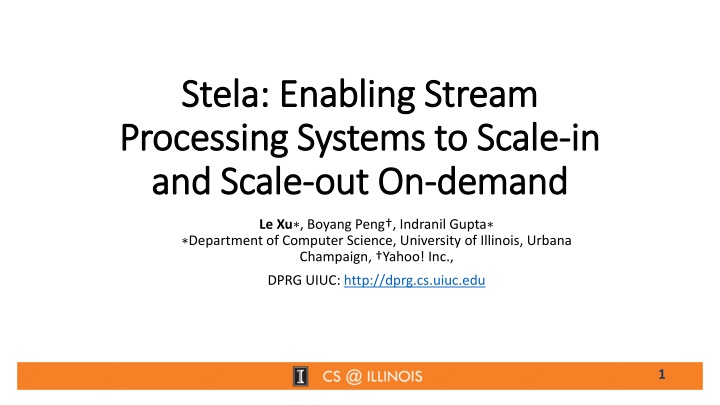Enhancing Stream Processing Systems with On-Demand Scalability
This study explores the importance of elasticity and on-demand scaling in stream processing systems, focusing on the development of the Stela system. It introduces novel metrics like Effective Throughput Percentage (ETP) and describes the implementation of on-demand elasticity within Storm without the need for hardware profiling or application code knowledge. The study evaluates the system's performance on various applications and provides insights into optimizing post-scaling throughput and minimizing interruptions during scaling operations.
Download Presentation

Please find below an Image/Link to download the presentation.
The content on the website is provided AS IS for your information and personal use only. It may not be sold, licensed, or shared on other websites without obtaining consent from the author.If you encounter any issues during the download, it is possible that the publisher has removed the file from their server.
You are allowed to download the files provided on this website for personal or commercial use, subject to the condition that they are used lawfully. All files are the property of their respective owners.
The content on the website is provided AS IS for your information and personal use only. It may not be sold, licensed, or shared on other websites without obtaining consent from the author.
E N D
Presentation Transcript
Stela Stela: Enabling Stream : Enabling Stream Processing Systems to Scale Processing Systems to Scale- -in and Scale and Scale- -out On out On- -demand in demand Le Xu , Boyang Peng , Indranil Gupta Department of Computer Science, University of Illinois, Urbana Champaign, Yahoo! Inc., DPRG UIUC: http://dprg.cs.uiuc.edu 1
Elasticity: - What is elasticity? - System s ability to scale out and scale in to adapt its workload change. - Important for real time stream processing systems - Existing Elasticity support in adaptive elasticity in stream processing systems - System S, Stormy, SEEP, etc. - What if the resource change is determined by users (on-demand) 2
Scale-out And Scale-in On-demand: - Why is it important? - Current systems, such as Storm, handles this inefficiently - Our two goals: - The post-scaling throughput (tuples per sec) should be optimized. - The interruption to the ongoing computation (while the scaling operation is being carried out) should be minimized. 3
Contributions of System Stela: 1.Development of novel metric ETP (Effective Throughput Percentage) 2.First work to describe and implement on-demand elasticity within Storm It requires neither hardware profiling nor knowledge of application code. We believe our solution can be applied to many other systems as well. 3.Evaluation of our system on micro-benchmark applications as well as on applications used in production 4
Data Processing Model - Directed acyclic graph of operators - Operators are stateless - Each operator is run by one or multiple instances (executors) at the same time 5
Effective Throughput Percentage (ETP) 2000 3000 - The percentage impact that an operator has towards the application throughput. - Effective throughput of operator o is the throughput of uncongested subcomponent of this operator 4 3000 1000 2 7 1000 1 1000 5 1000 8 3 500 200 9 6 10 300 An example of congested topology. (All execution rate in tuples/sec) 6
Find ETP For Each Operator 2000 3000 4 3000 1000 2 ETP of operator 3: (1000+1000)/ 4500=4/9 Output: 1000 tuples/s 7 1000 1 1000 5 1000 8 3 Output: 1000 tuples/s 500 200 9 6 Component # ETP Uncongested Subcomponent: A collection of uncongested paths leads to outputs. 10 1 0 300 3 0.44 4 0.44 An example of congested topology. (All execution rate in tuples/sec) 6 0.11 7
Component # ETP 1 0 Stela Scale-out 3 0.44 4 0.44 2000 6 0.11 3000 4 3000 1000 2 7 1000 1 1000 5 1000 8 3 500 200 9 6 10 300 8
Stela Scale-out: Step 1 Number of Instance slots: 10/5 = 2 + 7 5 3 1 9 ? 10 4 6 8 2 ? 1. compute N: # of instances being added on new machines N = # of new machines * current instance count / current machine count 9
Component # ETP 1 0 Stela Scale-out: Step 2 3 0.44 4 0.44 6 0.11 + 7 5 3 1 9 ? 10 4 6 8 2 ? 2. For each instance slot: Pick component C with highest ETP 10
Component # ETP 1 0 Stela Scale-out: Step 2 3 0.44 4 0.44 6 0.11 + 7 5 3 1 9 3 10 4 6 8 2 ? 2. For each instance slot: Pick component C with highest ETP 11
Component # Component # ETP ETP 1 0 1 0 Stela Scale-out: Step 4 3 0.44->0 0.44 3 4 0.44 0.44 4 2000 5 0.44 0.11 6 3000 4 6 0.11 3000 1000 2 7 1000 1 1000 2000 5 5 1000 8 3 3 500 200 9 3 6 10 300 ? For each instance slot: 3. Update C s execution rate assuming new instance assigned. 12
Component # ETP 1 0 Stela Scale-out: Step 4 3 0.44->0 4 0.44 5 0.44 6 0.11 + 7 5 3 1 9 ? 3 10 4 6 8 2 4 4. Update all components ETPs and repeat from 1. 13
Stela Scale-in: Step 1 ETP: 0 ETP: 0.88 ETP: 0.55 ETP: 0.44 ETP: 0.11 Which machine to remove? 7 5 3 1 9 0.44 0.44 0.22 0.04 0 10 4 6 8 2 0.44 0.11 0 0.22 0.07 1. Find ETPSum for all machines 14
Stela Scale-in: Step 2 ETP: 0 ETP: 0.88 ETP: 0.55 ETP: 0.44 ETP: 0.11 7 5 3 1 9 0.44 0.44 0.22 0.04 0 10 4 6 8 2 0.44 0.11 0 0.22 0.07 2. Remove machine with lowest ETP Sum 15
Stela Scale-in: Step 3 ETP: 0.88 ETP: 0.55 ETP: 0.44 ETP: 0.11 Ranked machine by ETPSum: 0.11<0.44<0.55<0.88 7 5 3 1 9 0.44 0.44 0.22 0.04 0 10 4 6 8 2 0.44 0.11 0 0.22 0.07 3. Round Robin schedule instances on removed machine starting with machine with lowest ETPSum. 16
Evaluation Experimental Setup (Emulab) 4-6 machines for micro- benchmark, 8 to 9 machines for real-world workload Scaling strategy: Storm Default Stela Linkedbase Load [1] PC3000 D710 Processor 3 GHZ dual core processor 2.4 GHz 64-bit Quad Core Memory 2GB 12GB Storage 146 GB SCSI disks 750 GB SATA disks [1] L. Aniello, R. Baldoni, and L. Querzoni, Adaptive online scheduling in Storm, in Proceedings of the 7th ACM International Conference on Distributed Event-based Systems. ACM, 2013, pp. 207 218. 18
Micro-Benchmark Topologies Linear Topology Star Topology Diamond Processing Topology 19
Micro-Benchmark Experimental Results +65% +45% +120% Linear: Cluster size 6 -> 7 Executor size 20 -> 23 Star: Cluster size 4 -> 5 Executor size 20 -> 25 Diamond: Cluster size 6 -> 7 Executor size 36 -> 42 20
Real-world Topologies Yahoo Processing Topology Yahoo PageLoad Topology IBM Network Topology 21
Real-world Topologies Experimental Results +80% +20% +80% Network Topology Cluster size 8 -> 9 Executor size 32 -> 36 PageLoad Topology: Cluster size 7 -> 8 Executor size 28 -> 36 Processing Topology Cluster size 8 -> 9 Executor size 32 -> 36 22
Convergence Time - Convergence time: the time it takes for the topology to reach its average post scale throughput. - Stela achieves shorter convergence time due to smart choice of executors restarted. Yahoo Topology 23
Scale-in Experiments Selecting the correct machine to remove is important Chance of Storm to pick the right set of machine(s) to remove is small (21% in this case) Stela achieves 87.5% and 75% less down time 24
Summary First work to describe and implement on-demand elasticity within Storm Takeaway: Development of novel metric ETP, which can be generally applied to most stream processing systems. For scale-out, Stela achieves throughput that is 22-120% higher than Storm s reduces interruption to 12.5% For scale-in, Stela performs 40-500% better Ongoing work: Multi-tenant adaptive stream processing 25
Thank you! DPRG: http://dprg.cs.uiuc.edu http://web.engr.illinois.edu/~lexu1/ lexu1@illinois.edu 26























